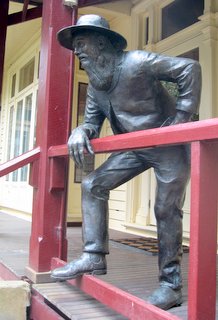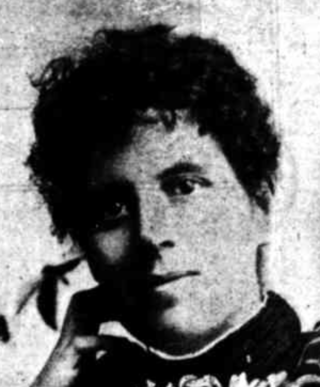
Isobel Marion Dorothea Mackellar was an Australian poet and fiction writer. Her poem "My Country" is widely known in Australia, especially its second stanza, which begins: "I love a sunburnt country / A land of sweeping plains, / Of ragged mountain ranges, / Of droughts and flooding rains."
The spasmodic poets were a group of British poets of the Victorian era. The term was coined by William Edmonstoune Aytoun with some derogatory as well as humorous intention. The epithet itself is attributed, by Thomas Carlyle, to Lord Byron.

Barcroft Henry Thomas Boake was an Australian stockman and poet who wrote primarily within the bush poetry tradition. He was active for only a few years before his suicide at the age of 26.

"The Man From Ironbark" is a poem by Australian bush poet Banjo Paterson. It is written in the iambic heptameter.

Leslie Allan Murray was an Australian poet, anthologist and critic. His career spanned over 40 years and he published nearly 30 volumes of poetry as well as two verse novels and collections of his prose writings.
John Bernard O'Hara was an Australian poet and schoolmaster.

Jennings Carmichael was an Australian poet and nurse.
— From Lewis Carroll's "Jabberwocky", published as part of Through the Looking Glass
Bertram William Mathyson Francis Stevens was Australian journal editor ; literary and art critic; and anthologist.

James Brunton Stephens was a Scottish-born Australian poet, and author of Convict Once.
"Where the Dead Men Lie" is a poem by Australian poet Barcroft Boake. It was first published in The Bulletin magazine on 19 December 1891, and later in the poet's poetry collection Where the Dead Men Lie, and Other Poems (1897).
This article presents a list of the historical events and publications of Australian literature during 1885.
Where the Pelican Builds is a poem by Australian poet Mary Hannay Foott. It was first published in The Bulletin magazine on 12 March 1881, and later in the poet's collection Where the Pelican Builds and Other Poems (1885).
This article presents a list of the historical events and publications of Australian literature during 1877.
Where the Dead Men Lie, and Other Poems (1897) is the first and only collection of poems by Australian poet Barcroft Boake. Edited by A. G. Stephens, it was released in hardback by Angus and Robertson in 1897, five years after the poet's death. It contains an introduction by the editor, an introductory poem by Will H. Ogilvie, and features the poet's major works "Jack's Last Muster", "Jim's Whip" and "Where the Dead Men Lie".
This article presents a list of the historical events and publications of Australian literature during 1873.

Fourteen Men : Verses (1954) is a collection of poetry by Australian poet Mary Gilmore. It won the ALS Gold Medal in 1954.
The Oxford Book of Australasian Verse (1918) is anthology of poems by Australian and New Zealand poets edited by Walter Murdoch. It was published in hardback by Oxford University Press in London in 1918.
"Peter Simson's Farm" (1896) is a poem by Australian poet Edward Dyson.
Fair Girls and Grey Horses : With Other Verses (1898) is the first collection of poems by Scottish-Australian poet Will H. Ogilvie. It was published in hardback by The Bulletin in Sydney in 1898.







